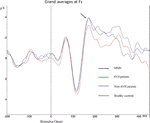

There are four main cognitive neurobiological models of AVHs. By first describing the cognitive neurobiological theories of AVHs, this essay will explore how functional neuroimaging studies have informed these views, and discuss the direction for future research in this area. 10 Advances in technology over the past 20 years have allowed us to utilise neuroimaging to better our understanding of these experiences, through both visualising the brain structurally, and exploring activity during AVHs using functional techniques. Our understanding of the aetiology of AVHs has come a long way since the Ancient Greeks implicated an excess of black bile humour, but it is still limited. 12 This has led to debate over the role of trauma in these experiences, illustrated by Laing’s iconic quote: “Insanity – a perfectly rational adjustment to an insane world”. 10, 11 This has led to an alternative view of AVHs that these experiences have important meaning to the hearer, allowing one to reflect on past experiences and guide future direction. Laing expressed his belief of the importance of the content of these hallucinations, and criticised the views of other psychiatrists stating that these hallucinations were “more socially intelligible than has come to be supposed by most psychiatrists”. 2, 9 Advances in medicine over the last hundred years saw the introduction of new treatments for AVHs, such as electroconvulsive therapy (ECT) and anti-psychotic medication. Hallucinations have long been recognised as a hallmark of mental illness, with literature on their aetiology dating back to the 19 th century. 7 Additionally, in mental illness, the patient’s insight into their condition is often limited, leaving them convinced of the voices objective reality. in frequency, clarity, content), but are frequently intrusive and malevolent, thus very debilitating. 6 These hallucinations vary over a number of dimensions (e.g. 2–4 AVHs also occur in other mental illnesses, including bipolar disorder (20-50%), post-traumatic stress disorder (40%) and major depression with psychotic features (10%), 5 as well as being reported by 10-20% of the general population.
#AUDITORY HALLUCINATION BRAIN ACTIVITY MANUAL#
1 Hallucinations of this modality hold great diagnostic significance, with Schneider’s (1959) first-rank symptoms of schizophrenia (including AVHs) still recognised today by major classification systems such as the International Classification of Diseases (ICD)-10 and the Diagnostic and Statistical Manual of Mental Disorders (DSM)-IV. Auditory verbal hallucinations (AVHs), or “hearing voices”, are a complex phenomenon characterised by abnormal perceptions of speech occurring in the absence of an appropriate external stimulus.


 0 kommentar(er)
0 kommentar(er)
